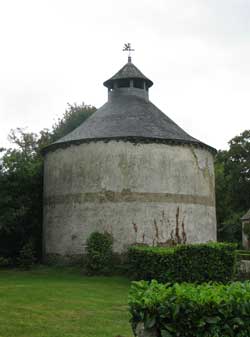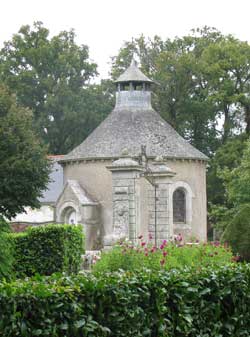
 |
 |
Monterrein dovecote |
Monterrein Chapel |
The round dovecote is of rather standard design and made of schist, but with an ornamental course of stone about halfway up. It is ornamental only, as it does not protrude beyond the wall as is common to provide both an inhibitor for climbing predators and a sunning ledge for the birds. The roof overhang, on the other hand, while also being fairly ornamental with corbelets nearly matching the chapel, would provide an effective inhibitor, as well as providing some protection from rain runoff from the roof. The pigeons gained entry by way of the central cupola on the apex of the roof. Interestingly, the chapel has a nearly matching cupola. The exterior wall is reported to be of unusual thickness, but we were not able to confirm this or to provide any other particulars, as the dovecote lies on private property. The dovecote is from around 1600, when the property was built for the Lopriac family, which resided there until 1755, then being sold to Francois Domenica de Boisbaudry, Conseiller at the Parliament of Brittany. The castle itself was plundered in 1794, but the dovecote did not suffer any damage, either then or during the Revolution.
Monterrein lies south of Pluemerl on the D8. Start at the church in Monterrein village and take the road immediately on the north side of the church, going west for .9km. The dovecote is not visible from the road, but it can be seen from the entry to the drive. The chapel is visible from the road, and it is built on the right side of the entry gate, just opposite the dovecote, making it rather simple to identfy the location.
 |
Dovecote of Trecesson |
Trecesson (I would call this a small castle, although it is more generally referred to as a manor house) was built at the end of 16th century by Jean de Trecesson, chamberlain of the Duke Jean IV, a Constable of Brittany. A person of some status indeed, whose tomb can be found in the church of Ploermel. In 1901, the house was acquired by Jean de Secondat, Baron de Montesquieu. Interesting how the French have kept such euphemistic titles as the English, considering that the French Revolution attempted to remove such anacronistic inequalities. The dovecote and the rest of the grounds are separated from the "castle" by a large moat. It is a lovely serene spot to spend some idle time, and enjoy some refreshments. We sat in front of the castle by the moat and found it a very romantic setting. The dovecote is within a 100 meters of the castle, and lies just 30 meters from the edge of the moat by which we picnicked.
The Dovecote is of circular design, the walls are about 20 feet in height, and it is in exceptionally great condition. Even the plaster covering the schist is all intact. It is hard to believe that such a beautiful setting and structure would allow anyone to defile the building. But as you can see in the picture, the dovecote has been tagged. Small wonder that many caretakers of these wonderful buildings often are forced to prohibit visitors entirely. In this case, the interior has been locked, undoubtedly to limit such malicious damage, but the 30 foot diameter of the exterior can yet be circumnavigated, and a knothole in the door provides a peek-a-boo view of the interior, which gives a gift view of the potence. The door(s) is rather odd. One appears to be newer, built above the older lower door. The newer door actually cuts into the rat course itself. Four little gables in the roof provided the only entry for the birds. Notice that the the cupola is completely enclosed, prohibiting access as well as limiting light and air within the cote. This type of entry is unique, being limited to this area of France, and being rare even here in Brittany.
 |
Dovecote of re Rox |
But our day was still not over, and again we found a dovecote visible from the side of the road, re Rox, on the D141, 1.7 km west of Concoret cemetery. To see a good view, take the turn a little before the house to the Le Chene Guillotin, park in the lot, and instead of going to the tree, curve right to a spot behind the manor grounds where the dovecote is easily visible across the field.
The dovecote is on private property, so we are only able to describe what we could see from a distance. But as you can see in the photograph, it is a nice find indeed. The structure is about 30 feet in diameter and about 18 feet high to the eve of the roof. The roof is the most noticeable feature, providing no cupola for light, air and access, but rather providing entry for the birds by way of only two gables.
As noted above for Trecesson, this type of entryway is rather unique. The gables in this instance are rather larger than those at Trecesson, but conceptually along the same line.
Area to the south and east of Rennes. ![]()
DAY |
||||||||||||||||||
| 00 | 01 | 02 | 03 | 04 | 05 | 06 | 07 | 08 | 09 | 10 | 11 | 12 | 13 | 14 | 16 | 17 | 18 | |